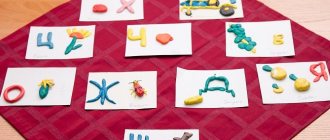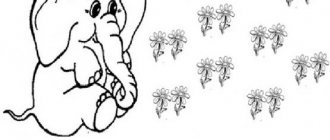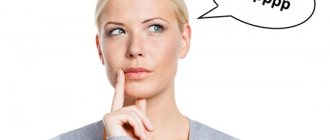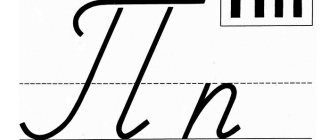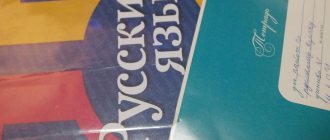Try showing your child the letter I with your body?
Ask him to repeat it? So, memorization is better through body language. You can also fold your fingers in the shape of the letter I, for example like this:
Can you repeat this? But mom takes something out of the closet or you hold a stick between your palms:
Which of the pictures do you remember best?
Syllable tables according to Zhukova’s method
A syllabic table for preschoolers, developed according to Zhukova’s ABC book, involves a step-by-step learning of the alphabet. The technique involves combining a sound approach with a speech therapy approach. Reading is carried out not with a single letter, but with a syllable. The same principle is pursued in N.S.’s primer. Zhukova.
The algorithm is as follows:
- The child learns several letters at once and puts them into syllables. Initially, vowels are studied - A, O, U. Learning to merge sounds is as follows - the first letter is drawn out, the second is played briefly. In Zhukova’s primer there is even a visual image where, between the syllable AU, a path is drawn along which a person moves.
Syllable table for preschoolers, developed according to Zhukova’s ABC book
Syllable table for preschoolers, developed according to Zhukova’s ABC book
Syllable table for preschoolers, developed according to Zhukova’s ABC book
Syllable table for preschoolers, developed according to Zhukova’s ABC book
Syllable table for preschoolers, developed according to Zhukova’s ABC book
Syllable table for preschoolers, developed according to Zhukova’s ABC book
Syllable table for preschoolers, developed according to Zhukova’s ABC book
- After fixing the vowels A, U, O, a syllabic table is used, with the consonants M, S, X, R, Sh. The child will try to read different variations of syllables - MA, OM, HA, UH, SHA, USH, RO, AR.
- Then the vowel letter Y and the consonants L, N, K, T are added to the table. The child learns to combine the vowel Y and previously learned consonants.
- Next, they study the letter I, in the table it is combined with the consonants - M, S, X, R, Sh, L, N, K, T.
- The syllabic table for preschoolers is also focused on learning the consonants P, Z, Y, G, V, D, B, Zh, they are combined with the vowels A, U, O, Y, I.
- Afterwards, the child is asked to learn the letters E, E, I, Yu, E. The table has a standard format: horizontally - four vowels, vertically - the studied consonants: M, S, X, R, Sh, L, N, K, T , P, Z, G, V, D, B.
- The consonants Ch, Ts, F, Shch are also highlighted in a separate table; they are combined with the vowels: A, U, O, Y, I, E, Yo, Yu, Ya. In this case, cells with incorrect combinations of sounds FYA, CHYU will be empty , CI.
- The final table combines all syllables with letters of the alphabet.
There are separate manuals, according to Zhukova’s ABC book, that involve connecting syllables of 3 or more letters. The principle is also based on the combination of syllables with vowels A, O, U; for example: SMA, SMO, SMU. Then there are tables with the letters I, Y (SMY, SLI). In this sequence, you can study any syllables, then you can start reading words.
Types of syllabic tables
Syllable charts serve as learning tools for preschoolers and help children become accustomed to the visual perception of letters and open syllables. The formation of reading skills is carried out from simple to more complex, therefore there are separate manuals for preschoolers and primary school students.
For preschoolers
This is the simplest type of tables, which reinforces the skill of forming simple syllables, while simultaneously learning letters. At this stage, the child learns to connect letters - at the intersection of horizontal and vertical. Understanding the sound-letter structure helps to perceive and read syllables as a whole.
Syllable table for preschoolers
Next, the child learns to quickly connect letters, then he can find the syllables that an adult reads. Preschoolers spend a lot of energy reading and reproducing two letters, so learning complex words at this stage is not advisable. The syllables are selected as simple as possible - KA-SHA, VO-DA.
For primary school students
At school, children are also taught letters, but the number of hours is limited and this may not be enough for the child. Initially, children are shown simple syllable tables. In order to consolidate the skill, tasks are immediately proposed, for example, for each syllable you need to come up with a word.
Schoolchildren are taught to use letters both at the beginning and at the end of words.
Syllable table for elementary school students
Syllable table for elementary school students
Syllable table for elementary school students
Syllable table for elementary school students
Syllable table for elementary school students
Then, they move on to studying closed syllables; there are also specialized tables for this. Combinations of letters with soft and hard signs cause difficulties. It is even more difficult to master the transitions from short to long syllables, so it is recommended to use the Zhukova and Zaitsev technique.
Zaitsev's syllabic tables
Zaitsev's method is based on reading by warehouses. The material is provided in the form of a set of cubes of different sizes, on which various letters and syllables are printed; the kit also includes 4 tables, they have a fairly large font.
It is believed that this technique is suitable even for the smallest children, since children have a visual aid. The cubes have special fillers, which makes it easier for a child to understand where a hard, soft or ringing sound is. Syllables are written in different colors.
Zaitsev's syllabic tables
Zaitsev's syllabic tables
A preschooler forms an image of a warehouse based on sensations, without separating letters from words. Logical thinking is also formed by visually consolidating information in tabular form. Classes are conducted in a playful way, but at the same time, fluent reading skills are reinforced.
However, schoolchildren who were taught using this method experience difficulties in tasks where it is necessary to highlight syllables, since the warehouses do not coincide with them. For example, in the word HANDLE, there are 2 syllables - RU-CHKA, but it consists of 3 warehouses - RU-CH-KA.
Types of exercises with syllable tables
Nowadays everyone has a computer, so printing out the table and cards is not particularly difficult. As a last resort, you can draw the manual manually. The study must be carried out in stages, more clearly in the table below.
| Type of exercise | Example | Methodology |
| Learning simple open syllables | BA, KU, MI, TO | One column needs to be read for several days until the material is completely consolidated. You can read both left-to-right and right-to-left. |
| Studying closed syllables | MOL, OX, POL | You need to create several similar tables, with different consonants, and change them periodically. |
| Learning words with a combination of vowels and consonants, consisting of 4 letters | DARKNESS, SLAN, MARRIAGE, TABLE | The child trains to connect different combinations of letters; non-existent combinations can be used. |
| Learning difficult to read letter combinations | ARKAN, BROMC, VROX, TRIBS | The child consolidates the skill of speed reading. |
| Studying syllables with b, b, j | EAT, LYA, IODINE | The skill of sound pronunciation for difficult letter combinations is strengthened. |
It’s difficult for kids to immediately get involved in their studies and learn the concepts of open and closed syllables. To begin with, you can consolidate the skill in a game form.
There are these types of games:
- Word breakdown. For this, both a syllabic table and cards are used. For example, the word needs to be composed of the word KO-RA, the child must find these syllables.
- Consolidating the skill of learning a syllable. For example, on the letter K, the child needs to come up with a word with the combination KA, KO - CAT, COW.
- Auditory memory training. For learning, cards are already needed, the adult makes up a word in front of the child and adds an extra syllable, for example - MA-SO-SHA, the preschooler must determine where the mistake is.
If a child finds it difficult to name a letter, you can help, but you should not name it separately, but read the entire syllable. This way there will be no pauses while reading.
